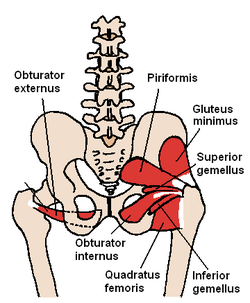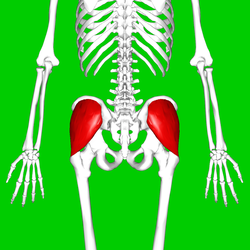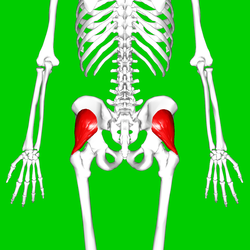MCEM Part A Study Guide/Anatomy/Lower Limb
Hip joint & gluteal region
[edit | edit source]Cutaneous innervation
[edit | edit source]Muscles
[edit | edit source]
Piriformis, obturator internus and quadratus femoris act synergistically around the hip joint. They:
- Stabilise the femoral head in the acetabulum.
- Laterally rotate the thigh at the hip.
Sciatic nerve
[edit | edit source]
The sciatic nerve is the largest nerve in the body, measuring 2 cm in breadth, and is the continuation of the flattened band of the sacral plexus.
It passes out of the pelvis through the greater sciatic foramen, below the piriformis muscle. It descends between the greater trochanter of the femur and the tuberosity of the ischium, and along the back of the thigh to about its lower third, where it divides into two large branches, the tibial and common peroneal nerves. This division may take place at any point between the sacral plexus and the lower third of the thigh.
In the upper part of its course the nerve rests upon the posterior surface of the ischium, the obturator internus and gemelli, and the quadratus femoris; it is covered by the Glutæus maximus. The course of the sciatic nerve can be indicated by a line from a point midway between the outer border of the ischial tuberosity and the posterior superior angle of the greater trochanter to the upper angle of the popliteal fossa.
The thick muscles of the gluteal region are commonly used as a site for intramuscular injection. However, care must be taken to avoid the sciatic nerve when giving such injections, as it can be accidentally damaged if care is not taken to avoid it. IM injections can be safely administered in the gluteal region well away from the sciatic nerve by:
- dividing the buttock into four imaginary quadrants, and staying within the upper outer quadrant
- drawing an imaginary line between the posterior superior iliac spine and the greater trochanter, and staying superolateral to this line




